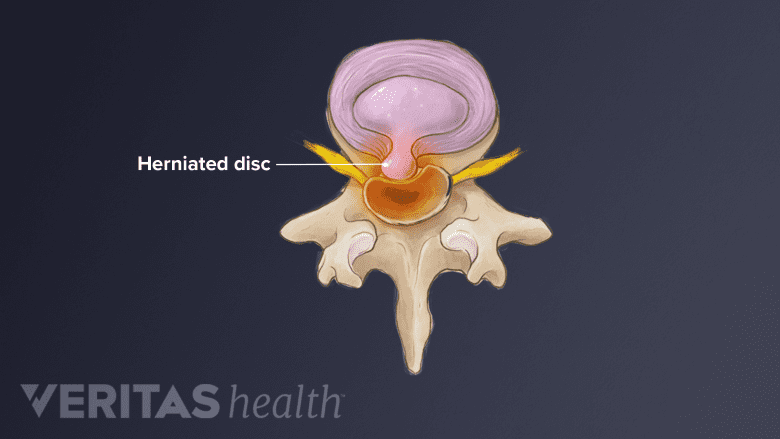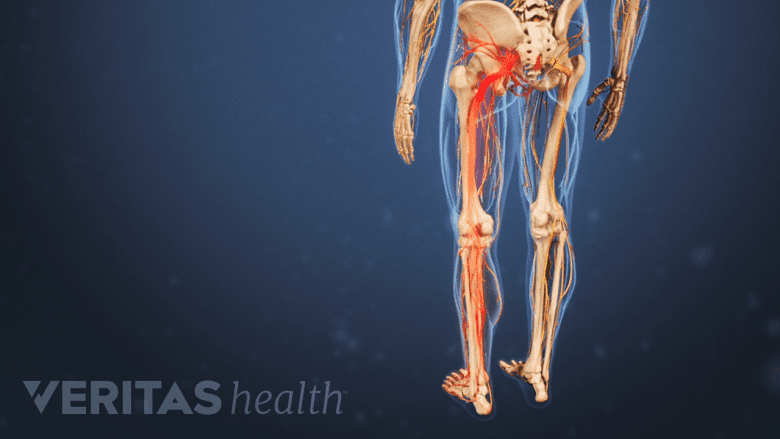Typically performed for a herniated disc, a microdiscectomy, also called a microdecompression, relieves the pressure on a spinal nerve root by removing the material causing the pain.
During the surgery, a small part of the disc material and/or bone impinging the nerve root is taken out.
The procedure may also be performed in the cervical spine (neck) to treat herniated discs in the neck and is called posterior cervical decompression.
In This Article:
- Microdiscectomy (Microdecompression) Spine Surgery
- How Microdiscectomy Surgery Is Performed
- Microdiscectomy Spine Surgery: Risks, Complications, and Success Rates
- Lumbar Microdiscectomy Surgery Video
How Microdiscectomy Works in the Lower Back
Microdiscectomy is considered the gold standard surgical procedure for treating most lumbar (low back) disc herniations – a condition where the disc’s inner soft core (nucleus pulposus) starts to leak into cracks or tears in the outer layer (annulus fibrosus).
- The surgery involves removal of the herniated disc material that compresses the spinal nerve or spinal cord.
- During the surgery, surrounding muscles and ligaments may be cut or spread (depending on the approach) to access the disc area.
- A laminectomy (spinal decompression) surgery may also be performed at the same time where a very small amount of bone is cut and removed to provide more space between the vertebrae and relieve impingement of the nerve.
Patients normally feel pain relief almost immediately after a microdiscectomy and go home from the surgery with significant pain relief. For numbness, weakness, or other neurological signs in the leg and foot, it may take weeks or months for the nerve root to heal and reduce or eliminate any residual numbness or weakness.
A microdiscectomy is typically performed by an orthopedic surgeon or neurosurgeon who specializes in treating musculoskeletal spinal conditions.
Microdiscectomy Success Rates

Microdiscectomy is the preferred method to alleviate nerve compression due to a herniated disc.
Microdiscectomy is considered to have relatively high rates of success, especially in relieving leg pain (sciatica). Patients are usually able to return to a normal level of activity fairly quickly.,
Microdiscectomy vs nonsurgical treatment
Medical literature points to some benefits of a microdiscectomy surgery when compared with only nonsurgical treatment, though the difference lessens over time in certain cases.
One large study found that people who had surgery for a lumbar herniated disc had greater improvement in symptoms for up to two years than those who did not have surgery.
As a general guideline, an appropriate course of nonsurgical care is tried for 6 to 8 weeks prior to considering surgery, unless there is severe pain with or without progressive weakness and/or numbness that needs urgent intervention
See Non-Surgical Treatment for a Lumbar Herniated Disc
When Microdiscectomy May Be Recommended

Leg pain (sciatica) lasting more than 6 weeks may be treated with microdisectomy.
Lumbar microdiscectomy may be indicated when,:
- Imaging evidence (eg, a magnetic resonance imaging (MRI) or computed tomography (CT) scan with contrast) shows a disc herniation that corresponds with the patient’s signs and symptoms
- Progressive neurological symptoms and disabling pain are constant or worsen despite 6-8 weeks of nonsurgical treatments
- Leg pain is the dominant symptom and more severe than back pain
Microdiscectomy is not performed when medical emergencies, such as cauda equina syndrome, spinal tumors, or spinal infection are suspected or confirmed.
The procedure is also not considered when there is segmental instability due to severe degeneration in the affected spinal segment or multiple levels of the spine. In such cases, a microdiscectomy and lumbar spinal fusion surgery may be performed simultaneously.
Deciding to Have Microdiscectomy
Leg pain due to a disc herniation generally gets better within 8-12 weeks of the onset of pain. As long as the pain is tolerable and the patient can function adequately, it is usually advisable to postpone surgery and see if the pain resolves with non-surgical treatments.
If the leg pain is severe, however, it is also reasonable to consider surgery sooner. For example, if despite nonsurgical treatment the patient experiences severe pain that affects sleep, work, or the ability to perform everyday activities, surgery may be considered.
The results of surgery are somewhat less favorable 3-6 months have passed since the onset of symptoms, so doctors usually advise people not to postpone surgery for an extended period (beyond 3-6 months).
Surgical Approaches for Microdiscectomy
Microdiscectomy uses smaller incisions compared to open discectomy surgery.
A microdiscectomy can be done in 2 ways:
- Traditional microdiscectomy: Surgery performed with the use of a magnification device, such as a microscope or surgical loupes. This approach uses smaller incisions compared to an open discectomy surgery and less soft tissue resection to view the disc space.
- Endoscopic discectomy: A minimally invasive surgery that causes minimal tissue damage and accesses the disc through an endoscope.
Endoscopic microdiscectomy may be further classified as transforaminal percutaneous discectomy (the disc is accessed from the side) and percutaneous interlaminar discectomy (the disc is accessed from the back).
Endoscopic Discectomy: A Minimally Invasive Alternative to Microdiscectomy
Endoscopic discectomy, also called percutaneous discectomy or micro-endoscopic discectomy, is a less invasive alternative to microdiscectomy surgery.
In an endoscopic discectomy, a working channel that connects the incision to the spinal disc is created with the help of surgical dilators. A tube-shaped surgical instrument equipped with a light and camera lens, called an endoscope, and other surgical instruments, such as forceps, are inserted through this working channel to access and treat the disc.
Patients are discharged based on their pain level, ability to walk without assistance, and the ability to use the restroom independently.
See Lumbar Discectomy Outpatient Spine Surgery
Potential benefits of endoscopic discectomy
Potential benefits offered by the endoscopic procedure when compared to microdiscectomy are:
- A smaller incision
- Less muscular retraction
- Less bone removal
- Minimal manipulation of nervous tissue
- May be performed under local anesthesia
- Less blood loss
- Shorter operative time
These benefits may allow for quicker recovery, enabling an early return to activities of daily living.
Types of Disc Disorders Treated with Microdiscectomy

Varying degrees of disc herniation may be treated with microdiscectomy.
Microdiscectomy is typically indicated for herniated lumbar discs.
A disc can herniate in 3 ways:
- Disc protrusion: when the nucleus pulposus leaks into the outer layer but not beyond its boundary
- Disc extrusion: when the nucleus pulposus starts to leak beyond the boundary of the outer layer
- Disc sequestration: when a part or fragment of the disc separates from the rest of the disc
Depending on the area they protrude into, the herniated part of the disc may affect the spinal cord and/or spinal nerve root(s).
Herniated discs may be further classified as:
- Central herniations: discs that herniate into the spinal canal
- Lateral recess herniations: discs that herniate between the spinal cord and the intervertebral foramen (the space through which the nerves exit the spinal canal)
- Foraminal herniations: discs that protrude or herniate directly into the intervertebral foramen
- Far lateral herniations: discs that herniate beyond the intervertebral foramen
Lateral, foraminal, and far lateral herniations are usually more common than central herniations.
Central herniations may affect the spinal cord and lateral recess herniations can affect the spinal cord and/or the spinal nerves. Foraminal and far lateral herniations typically cause nerve root-related symptoms and signs in the leg, such as sciatica.
All of the above types of herniations may be treated with microdiscectomy.
Amount of Disc Material Removed in Microdiscectomy
The amount of disc material removed in microdiscectomy varies and may range from removing small fragments of the disc to cutting out a significant part of the disc.
The surrounding bony tissue, such as the lamina, facet joints, or enlarged bone (bone spurs) may be undercut or trimmed to relieve nerve root pressure.
Since almost all the joints, ligaments, and muscles are left intact, a microdiscectomy does not change the mechanical structure of the patient's lower spine (lumbar spine).
Microdiscectomy vs Lumbar Spinal Fusion for Herniated Discs

Spinal fusion can be used for enhanced stability in degeneration or trauma cases.
Microdiscectomy is considered the most common spinal surgery and the one that produces the most reliable outcomes for a lumbar herniated disc.
Extensive research indicates that lumbar microdiscectomy may be more effective at improving leg pain, functional disability, and quality of life than other common spine procedures, such as lumbar spinal fusion.
In cases where additional stability is needed due to degeneration or trauma, spinal fusion may be performed simultaneously with the microdiscectomy.
Disc Healing and Recurrent Herniation After Microdiscectomy
Research indicates that 3% to 10% of surgically treated herniated discs may eventually recur. Recurrence of herniation may or may not cause symptoms. Around 10% of people who experience symptoms from a recurred herniation eventually opt for surgery to manage their symptoms.
It is essential to have clear and detailed conversations about the type of herniation and the choice of surgical approach, including the risks, benefits and alternatives to surgery. Patients are also encouraged to discuss the healing process and return to activity, which can help them manage their expectations and goals after surgery.
